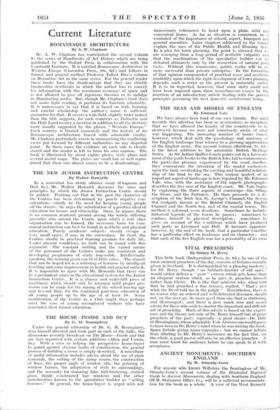THE NEW JUNIOR INSTRUCTION CENTRE
By Walter Howarth
In a somewhat too richly allusive essay (Chapman and Hall, Gs.), Mr. Walter Howarth discusses the aims and principles by which the Junior Instruction Centre should be guided. Pointing out that in the past the character of the Centres has been determined by purely negative con- siderations—chiefly by the need for keeping young people off the streets—he urges the substitution of a positive ideal of education for leisure and citizenship. Since, he argues, there is no common academic ground among the widely differing ' juveniles who attend the Centre upon which a real class organisation can be formed, the necessary basis for com- munal instruction can best be found in aesthetic and physical education. Purely academic subjects should occupy a very small space, if any, in the curriculum. In short, the Centres should be practical training grounds for daily life. Under present conditions, no fault can be found with this argument. The constant shifting and the varied nature of the personnel of the Centres make any consistent and developing programme of study impossible. Intellectually speaking, the training given can be of little value. The utmost that can be hoped for is a widening of horizons by intelligent teaching and some improvement in health and general outlook. It is impossible to agree with Mr. Howarth that there can be a permanent place in the educational system for the Junior Instruction Centre. It is a clumsy and makeshift piece of machinery which should only be retained until proper pro- vision can be made for the raising of the school leaving age and beyond that, for the continued part-time education of all young people up to the age of at least IS. Some modification of the Centre as a Club might then perhaps meet the ease of young unemployed workers who have concluded their formal education.














































 Previous page
Previous page